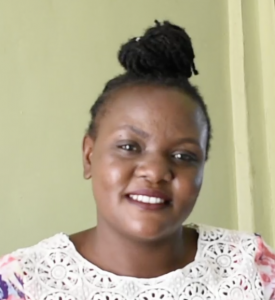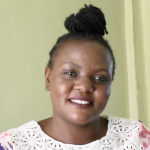The community of Buloma is made up of 245 people who face a daily struggle to access safe water. Although their spring was once protected, it is now in hazardous disrepair, leaving community members vulnerable to contamination and waterborne illnesses.

Field Officer Adelaide Nasimiyu shared, "Most people who use this water for drinking have suffered from different illness[es]. Some have had diarrhea, others Typhoid and some have had stomachaches. If you have to drink this water, you have to boil or chlorinate [it] before drinking, but because of [a] lack of money, some of the users are forced to drink untreated water."
"This water is not very clean; if you drink it direct from the source, you become sick. Many people have been diagnosed with Typhoid, diarrhea, and stomach-related diseases. One has to treat [it] with chlorine for the water to be safe for drinking," said farmer Rehema Ashioya, 34, pictured below.

But contamination isn't the waterpoint's only problem.
Due to the leakage in the spring walls, the amount of water discharged from the pipe is slower than normal. Consequently, people must wait in long queues to fill their Jerricans as it takes considerable time. Some individuals must make up to ten daily trips to collect enough water for their daily needs. This makes it a full-time task to acquire unsafe water, which poses a significant risk to the community members.
"Fetching water is not one of my favorite house chores at home. Most of the time, when fetching water, you get a long queue at the water point. This makes you waste a lot of time at the water point. The time wasted I [could] use to study instead of wasting it in sitting and waiting for my turn to draw water," said Nuzra N., 12, pictured below collecting water.

When community members are forced to wait in long lines to collect contaminated water, they aren't only risking their health. Most people in the Buloma Community are farmers, so their time is precious. Any time not spent farming is taking away from their livelihoods. They lose out on accruing crucial resources and must use funds on medication to treat waterborne illnesses instead of making progress.
Buloma Community members need access to safe, clean water. To improve their lives, they need the tools and uncontaminated water is a good first step.

Protecting the Buloma Community spring will enable Rehema to focus on tending her farm instead of wasting her time and precious resources on sickness and medication. And Nuzra can use the time she once spent waiting in line for water on her education, allowing her the opportunity to dream of a better future for herself.
The Proposed Solution, Determined Together...
At The Water Project, everyone has a part in conversations and solutions. We operate in transparency, believing it benefits everyone. We expect reliability from one another as well as our water solutions. Everyone involved makes this possible through hard work and dedication.
In a joint discovery process, community members determine their most advantageous water solution alongside our technical experts. Read more specifics about this solution on the What We're Building tab of this project page. Then, community members lend their support by collecting needed construction materials (sometimes for months ahead of time!), providing labor alongside our artisans, sheltering and feeding the builders, and supplying additional resources.
Water Access for Everyone
This water project is one piece in a large puzzle. In Kenya, Sierra Leone, and Uganda, we're working toward complete coverage of reliable, maintained water sources that guarantee public access now and in the future within a 30-minute round trip for each community, household, school, and health center. One day, we hope to report that this has been achieved!
Training on Health, Hygiene & More
With the community's input, we've identified topics where training will increase positive health outcomes at personal, household, and community levels. We'll coordinate with them to find the best training date. Some examples of what we train communities on are:
- Improved hygiene, health, and sanitation habits
- Safe water handling, storage & treatment
- Disease prevention and proper handwashing
- Income-generation
- Community leadership, governance, & election of a water committee
- Operation and maintenance of the water point
Chlorine Dispensers
Installing chlorine dispensers is an important piece of our spring protection projects. Protecting a spring provides community members with an improved water source, but it doesn’t prevent contamination once the water is collected and stored. For example, if the water is clean and the container is dirty, the water will become contaminated.
We ensure that each chlorine dispenser is filled with diluted chlorine on a consistent schedule so that people can add pre-measured drops to each container of water they collect. That way, community members can feel even more confident in the quality of their water.




 Protected Spring
Protected Spring
 Rehabilitation Project
Rehabilitation Project

































